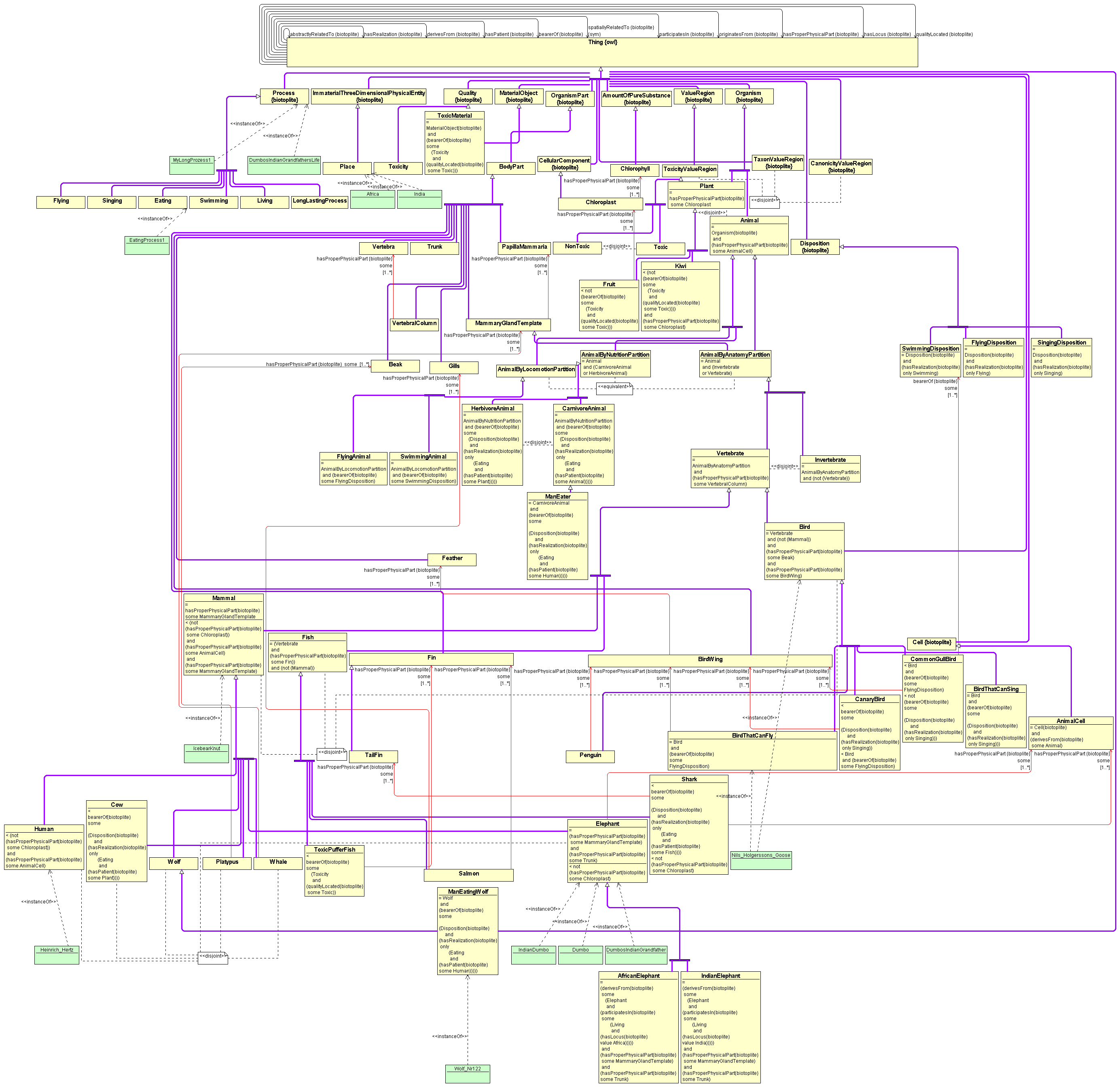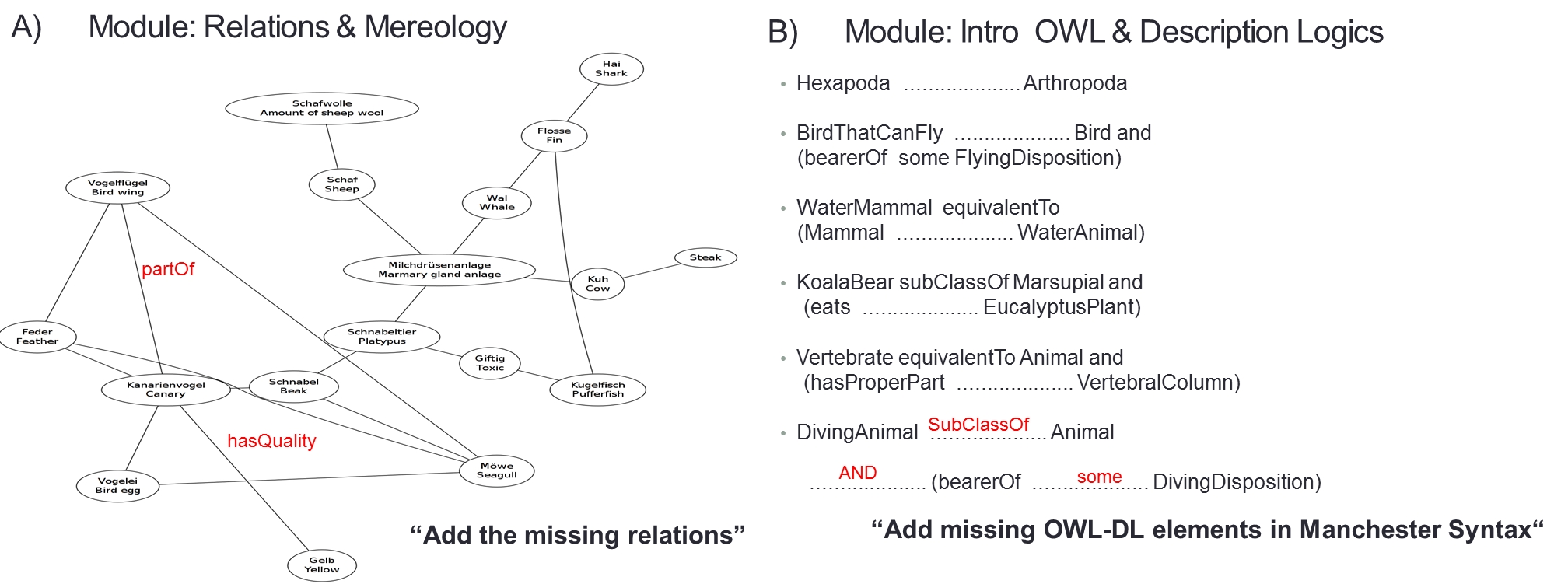A didactically sound example-ontology
for teaching description
logics in OWL 2
Motivation
Over the
years several OWL ontologies have been published to serve as training
examples in
teaching the principles of description logics and ontology development
to a wide audience.
As
some of these resources make no commitment to the biomedical target
domain, they increase the learning threshold
by adding the burden of an unfamiliar topic area in addition to the
technicalities and
the intended domain independent description logics principles.We argue that the
outstanding role of formal ontologies
in the life sciences is important enough to warrant a robust teaching
ontology
that is optimized for the biomedical ontology novice intending to learn
the basics of description logics in OWL 2. We present a list of
requirements for user compliant teaching ontologies
and exemplify
these in the ZooAnimal Ontology justifying design
decisions
with intuitive teaching examples and exercises, carried out and tested
in a
didactical teaching effort, the GoodOD summer school:
The GoodOD Project,
http://www.iph.uni-rostock.de/Good-Ontology-Design.902.0.html
Boeker, M et al. “Teaching Good Biomedical Ontology
Design”
In: Proceedings
of the 3rdInternational
Conference on Biomedical Ontology
(ICBO), 2012.
Download
&
Installation
ZooAnimals.owl
Overall Class
Structure:

Example
Usages
in an Ontology
Engineering Teaching Curriculum
Example
exercises from the GoodOD curriculum, illustrating the ZooAnimal
ontology in use: A) Example of a task in the curriculum
within the Relations-Module. The students had to add the missing object
properties (red) to a given graph excerpt from the Zoo Animal ontology.
B) An exercise from the DL intro module, where the students had to fill
in missing constructors and operators for given ontologic statements.

Competency
Questions
Here we list a few queries our ontology (or an annotated data
set/knowledgebase?) should be able to provide correct answers for:
-
What animals are carnivores, what are
Omnivores ?
-
What animals live always in the water ?
-
Why is the whale not a fish ?
(Surface Breather: Has Lungs, not Gills)
-
What animals have the disposition to fly ?
(Flying Fish? Flying Lizards, Bats,
-
Can all birds fly ? (Kiwi, Ostrich)
-
What is the difference between reptiles and
birds ?
-
Why are birds and reptiles not disjoint?
(Archaeopteryx)
Competency Questions currently beyond the scope:
- Does Frogs and ‘Knut’ live in the
water ? (Instance level, Knut is not living at all, he is only hunting
in water, but mostly lives on Ice (role of land?))
- Are there humans with two heads ? 6 toes
? (cannot be modeled . And even if, it would require an extremely
sophisticated anatomy including all the exceptions)
- Is the Kiwi a bird or a fruit ? (Homonyms)
- What is an Organism ? (N&S def)
- Why is the Portuguese Man o' War (Physalia
physalis) not a jellyfish and not an organism ? (It is a colony of
multiple specialised individuals/organisms. Or can a colony be seen as
an individual organism ? Biologists can define this
somehow or other. Is there a consensus ?)
- What is an Organ ? (the Portuguese Man o' War builds Organs from specialised individuals.)
- What is life ? What is death ? (Bacteria
display no natural death due to age and there are no corpses. They
merely divide.)
- Are human germline cells immortal ?
- What taxonomic classes are found in the Humans
phylogenetic tree ? (Apes, Mammals, Reptiles, Amphibia, Fish, Chordata,
..., a second-order problem )
- Human Embryos live in some kind of water and
even develop rudimentary gills at certain stages. Atavisms occur, e.g.
Humans with tails
Extensions
discussed
Further
classes and potential patterns
that were discussed to be included:
- Processes:
Are currently
only included as flat undefined classes serving dispositions that are
needed for partitions, e.g. Flying for the AnimalsThatFly Partition. No
process part orders or temporal parts have been defined yet.
- Roles and Functions:
"What animals are pets of humans ?"
- Property Chains
- Relative and absolute time
models: Timing of events in
processes: e.g. the caterpillar transforms to a larva and does a
metamorphosis to a butterfly if the temperature and humidity conditions
are suitable.
- Defaults,
Causality, Uncertainty: i.e. representation of
“may”, “typical”, qualitative
reasoning under
uncertainty:
e.g. “Pneumonia may be caused by
bacteria”. “A
workers bee larva may
develop into a queen bee, if it is fed with gelee royal, a special
hormone rich food." “The typical lifespan of a
whale, if
not hunted,
is around 80 years” "The Lung Fish is a fish that can live on
land for
extended periods."
- Approximation, qualitative
values, proportion etc. of measures:
e.g. “Whales can dive
deeper than 2000 meters for short periods of time”
- Synergetics:
Cases in
which the whole of parts is the product rather than the sum of its
parts, i.e. properties of things change, emergent properties like a bee
hive that is a meta-organism.
- Explanations:
“A
whale is a mammal and not a fish because it has milk glands and is
air-breathing and has lungs, rather than an air-bladder and gills as
fish have.”
- Hypothetical statements,
particularly as parts of explanations:
e.g. “Eusocial
Insect colonies (like the termites, bees) use decentralised,
self-organised systems of activity guided by swarm intelligence to
exploit food sources and environments that would not be available to
any single insect acting alone. Social behaviour provides economic
benefits for all participants as long as the social group is not
distorted."
- Relative measure, maximum,
minimum: e.g. “Owls
lay between 2 and 6 eggs per year."
"Birds have varying ages from 3 to 150 years.”,
“The Parrot
lives as long as humans. “, “Some turtles live 3
times as
long as humans.", "The grown up elephant weigths more than 10 times
that of its birth weight".
- Representation of context:
e.g. “In older ice bears the illness is rarely serious, but
in
infants in can be fatal”.
Contact
&
Questions
ZooAminals.owl
is provided free of cost,
is published under the terms of the GNU General Public License and is,
of course, provided without any warranty.
If there are still features missing,
please contact us:
dschober
at ipb-halle.de
Acknowledgements
This
work is supported by the German Science
Foundation (DFG)
as part of the research project JA 1904/2-1, SCHU 2515/1-1 GoodOD (Good
Ontology Design)


